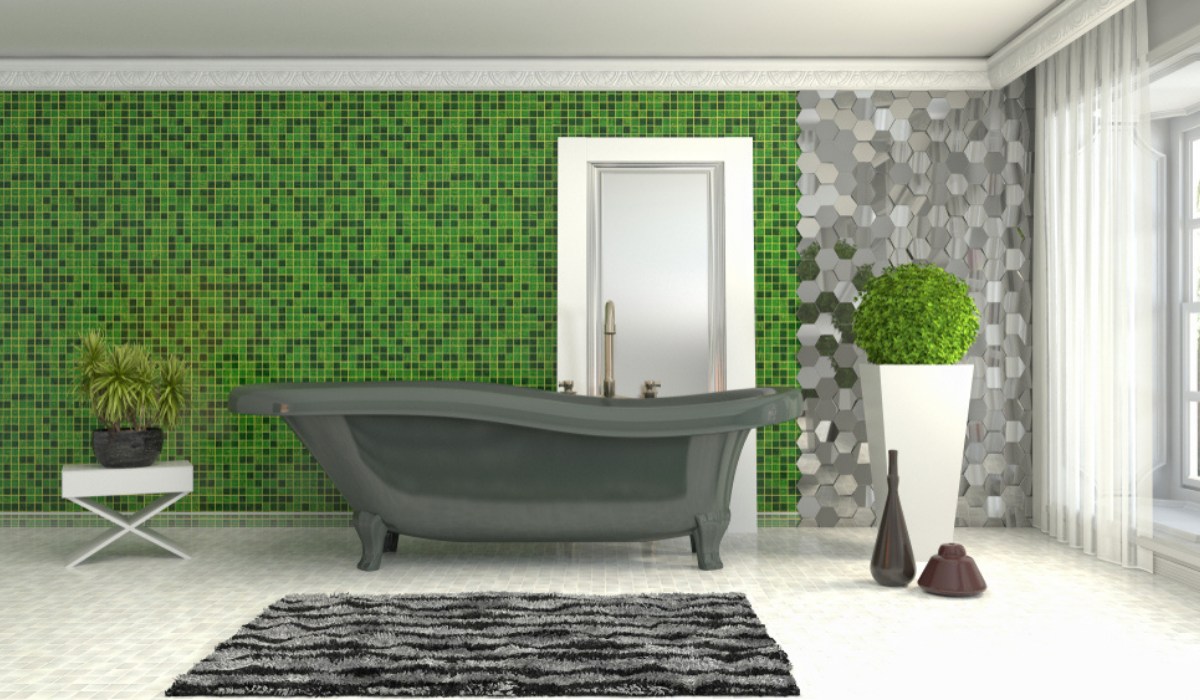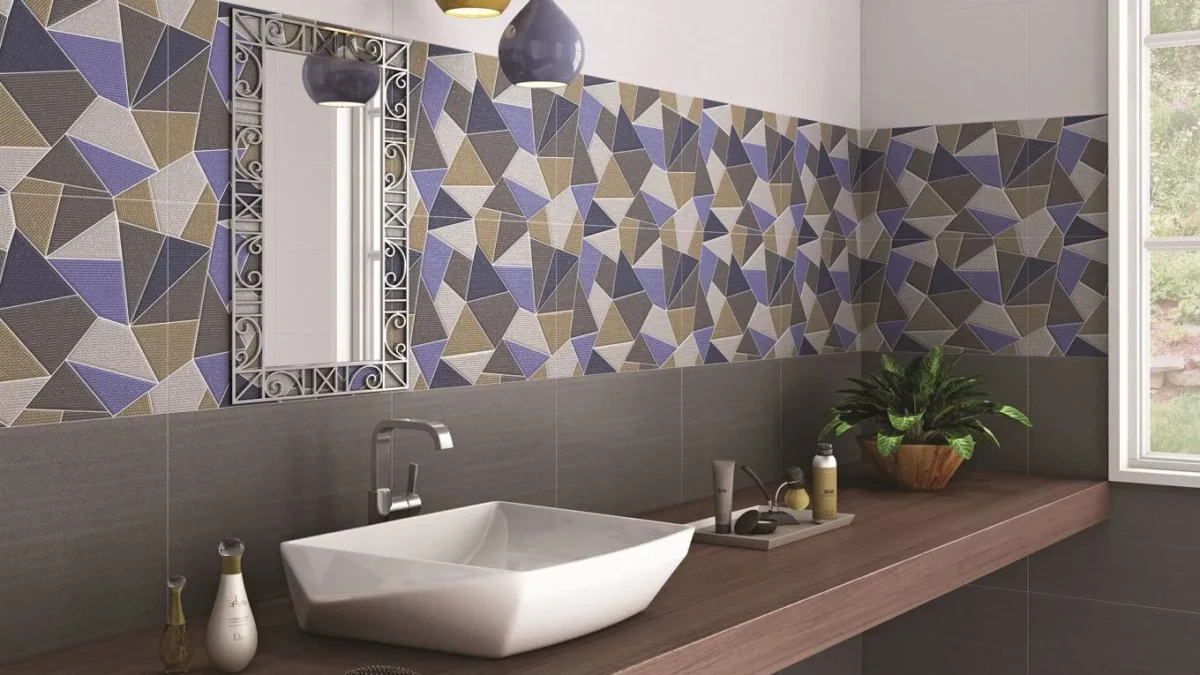Terracotta bathroom tiles are a gorgeous red clay tile that has been fired at low temperatures. It has a warm and natural feel to it due to its rustic quality. Because it is porous, it must be sealed on a regular basis to prevent stains. It is only ideal for dry places, although if glazed, it may also be used in bathrooms.

Travertine Tiles: Travertine is a porous natural stone that belongs to the limestone family. It’s known for its distinct look, a wide variety of designs and patterns, and a wide range of colors. Travertine bathroom tiles are more affordable than marble, which is why most people choose them. It’s also available in a variety of sizes. Travertine is increasingly popular for decorating and flooring bathrooms and showers because of its wide variety of sizes. Because it’s a porous stone, you need always apply a sealer and a finish to keep it dry.
Saltillo Tiles: Compared to other bathroom tiles, Saltillo tiles are more elegant, handmade, and durable. If properly sealed to reduce water absorption and slipperiness, they are suitable for bathroom floors and walls. They’re also simple to clean and last a long time.

Slate Tiles: Slate tile is the most popular tile option for bathroom flooring. Slate is a stone with a fine texture. It features a textured, naturally slipping-resistant surface. It’s suitable for use on floors, walls, and counters.

Quarry tiles are hard tiles comprised of ground minerals that have been burned at high temperatures. They’re frequently more durable than regular bricks. These tiles are both water-resistant and non-porous. They come in a variety of colors, shapes, and sizes.
Tips for Choosing Bathroom Tiles:

There are numerous elements to consider while planning or remodeling a bathroom in order to get the desired aesthetic. The one you anticipate loving the most is selecting the bathroom tiles. However, due to the huge variety of bathroom tiles available in terms of colors, styles, sizes, textures, and other qualities, the selection process of bathroom tiles may be exhausting and stressful rather than enjoyable and exciting. Here are some pointers to consider while selecting tiles for your bathroom:
- Complete your homework:
Setting some time to conduct your study before choosing bathroom tiles is essential. Learn about the many varieties of bathroom tiles on the market, such as porcelain, concrete, natural stone, marble, terracotta, glass, and stone. In the market, there are far too many forms, sizes, patterns, styles, and qualities to choose from. So, figure out which tiles you prefer and which bathroom tiles are appropriate for the space where they’ll be put.
- Try it before you purchase it:
Before purchasing a large number of tiles for your bathroom, always get a free sample. It is preferable to inspect the tiles before purchasing so that you do not end up with a pile of pricey bathroom tiles that are unsuitable for your bathroom. Purchasing a hundred square feet of black tiles, for example, may make the bathroom seem smaller, while purchasing a hundred square feet of ultra-glossy tiles may be equal to being very slippery. Those tiles aren’t appropriate for a bathroom. So, always obtain a sample before purchasing and double-check the tile’s size, style, pattern, and other characteristics, as well as execute a soak test for quality assurance.
- Pick one of the top three choices:
When you’re happy with the sample bathroom tiles, choose your top three choices. The floor, the shower, the area around the tub, and the statement wall, which is generally the wall behind the bathroom vanity, are the four places in the bathroom that must be tiled. As a result, never attempt to put all four kinds of bathroom tiles in any space or location. Instead of ending up with a colorful, juvenile, and unplanned bathroom appearance, use two to three tile selections and create a pattern with rhythm in all sections to make the whole bathroom distinctive, well-designed, and elegant. The secret is to only utilize three tiles at a time.
- Select a statement tile:
Select one statement tile that is distinct in terms of form, color, pattern, or texture. Select the other two basic bathroom tiles from the same color’s tints or shades to add a vow factor and help to accent the area, and with the statement tile, choose the other two simple tiles from the same color’s tints or shades to add a vow factor and help to focus the area. This will assist to draw attention to the region in the bathroom with the statement bathroom tiles.
- Space Maximization:
Use light color palettes or big patterned or designed tiles to optimize the space in the bathroom. Darker colors make a tiny bathroom seem smaller. Light colors, on the other hand, make a small bathroom appear larger. Choose tiles that are proportional to the size of the bathroom. Choose medium-sized tiles for a medium-sized bathroom and mosaic tiles for a tiny bathroom.
- Identify the Wow factor feature:
Before picking and purchasing bathroom tiles, decide which place you want to draw attention to. Will it be a backsplash, a shower enclosure, or an area around the tub? So, if you decide on the bathroom’s focal point or accent before choosing the tiles, it will be simple for you and will complement the selected element in the bathroom. You can read about Bathroom tiles for different bathrooms by clicking here.
- Take into account the cleaning and maintenance aspect:
It is common knowledge that the smoother the tile, the simpler it is to clean. If you pick embossed or textured tile, cleaning and maintaining it will be a little more challenging. So bear in mind that you’ll need to be a bit more dedicated and consistent with your cleaning program for these tiles. This will assist your tiles maintain their attractiveness and beauty for a long period.
- Select floor tiles:
If you’ve opted to keep the walls basic, go for a patterned tile floor instead. It’s the most recent craze. If you want to focus on the wall tiles, keep the flooring modest and complementing rather than big and dramatic.
One thing to bear in mind while purchasing floor tiles is that they must not be slick in order to prevent any mishaps.
- Be creative with tile layout:
Even if you choose plain tiles, it’s necessary to be creative or apply your artistic sense when laying out the tiles in the bathroom. Simple tiles, such as rectangular tiles or metro style tiles, may be used to create a variety of designs.
- Use tiles to provide texture:
It’s best to use tiles to bring texture to the bathroom. If you want your bathroom to have a spa-like vibe, choose nature-inspired tiles such as limestone, travertine, marble impression tiles, slate, natural stone tiles, and so on. Natural wood color tones may also be used to complement these textures.
- Slip and Water Resistant:
When selecting bathroom tiles, keep in mind that they must be slip-resistant in order to prevent accidents. Because the bathroom is the most humid room in the home, it should include a lot of absorbent material.
- Measurement and Re-Measurement:
After you’ve decided on the color, texture, material, pattern, and design of the tiles you’ll use, be sure to complete this step before purchasing bathroom tiles. Make a rough calculation of how much it will cost. Take measurements of the length and breadth of the space or area that will be tiled. Multiply these two figures together. Now add an additional 10% to 15% to the calculations to account for any mishaps, such as breakage and emergency, since the worst-case scenario is that the tiling project is nearing completion and you are running out of tiles and supplies, and the same tiles have been discontinued on the market.





